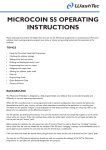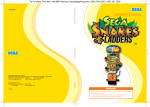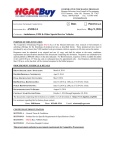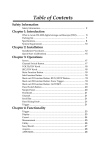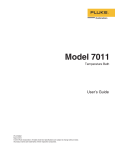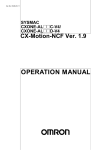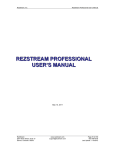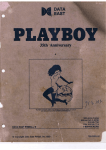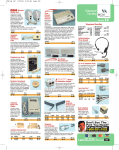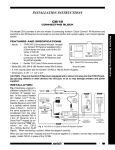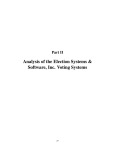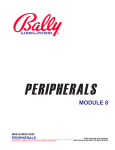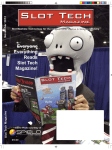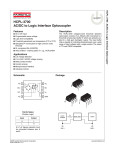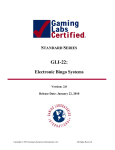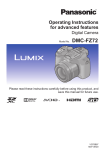Download casino school promopak
Transcript
Inside Slot Tech Magazine Magazine February 2004 Page 2 - Editorial Page 4 - IDX and Osborne Coinage Page 10 - Bally S6000 Part 2 Page 16 - PAR Excellance: Improve Your Edge Page 24 - GameMech 6000 Micro-Mech Page 25 - GLI Australia Granted First-Ever Testing Facilities License in New South Wales Page 26 - MCM Adds to Gaming Lineup With New Products & Services Page 27 - FutureLogic Opens 11,000 Sq. Ft. Distribution Center in Las Vegas to Serve Gaming OEMs Worldwide Page 28 - IGT Taps Microcoin QL Page 29 - GSA Submits Best of Breed & S2S Standards for Review Page 30 - Writing the Book - In Support of Technical Writers Page 34 - Vic Fortenbach Visits WIGC Page 35 - TechFest 8 - Clinton, Iowa TechFest 9 - Minneapolis, Minnesota Page 36 - Subscriptions and Back Issues Order form Have you FTP'd yet? See page 33 Slot Tech Editorial Blast From the Past A long time ago, in a galaxy far, far away, slot machines were the furthest thing from my mind. Back in 1972, the amusement machine business was just entering the “Golden Age” of videogames with the popular success of Atari’s “Pong.” Back then, slot machines were boring, electromechanical devices. Videogames were much more interesting and so that’s the path I followed as a technician. Of course, these were the days before the Internet so I shared what I learned by writing a monthly technical column for one of the industry trade journals, Play Meter Magazine. Randy Fromm's Slot Tech Magazine Editor Randy Fromm Technical Writers Dion Anderson Chris Appoldt Martin Dempsey Vic Fortenbach Bart Holden Kevin Noble Herschel W. Peeler Hendrik Sidaway John Wilson Advertising Manager Dennis Sable Slot Tech Magazine is published monthly by Slot Tech Magazine 1944 Falmouth Dr. El Cajon, CA 92020-2827 tel.619.593.6131 fax.619.593.6132 e-mail [email protected] Visit the website at slot-techs.com SUBSCRIPTIONS Domestic (USA) 1 year - $60.00 2 years - $120.00 International 1 year - $120.00 2 years - $240.00 Copyright 2004 under the Universal Copyright Convention. All rights reserved. Page 2 Along the way, Play Meter acquired another technical correspondent, a specialist in the repair of redemption games named Vic Fortenbach. Over the years, Vic contributed numerous articles on the subject, often specializing in the troubleshooting and repair of ticket dispensers. He was “Ticket Vic” and well known throughout the amusement machine industry. Fast-forward to the present and slot machines are finally something interesting to work on. I made the switch from amusements to gaming and apparently, so did Mr. Fortenbach who now works as a slot tech at The Spa Casino in Palm Springs, California. I received the following e-mail: Hi Randy.... Long time. I’m thinking of jumping in the authoring arena again by writing for Slot Tech magazine. What about a “starter article” about the upcoming WIGC show here in Palm Springs? I can cover it with photos and a “what’s new at the show” article. Let me know, Vic Fortenbach - Slot Technician Spa Resort Casino Well, that’s a long introduction to a short article about the Western Indian Gaming Conference. You can read Vic’s report on page 35. Nice to hear from you again, Vic. There’s a pretty interesting mix of things this month. Canadian Correspondent Kevin Noble took a field trip to the United States of America to visit Osborne Coinage and IDX. His report begins this month on page four. Part 2 of Herschel Peeler’s Bally S6000 article continues on page 10. Randy Fromm For the mathematically inclined, John Wilson presents us with another look at PAR sheets. John has a knack for actually making this stuff understandable and interesting, compelling one reader to write in: “Up ‘till now, no one has ever been able to answer what the volatility index was for, except for maybe a quick generic answer. I read your article and have absolutely no questions. Thanks for a very detailed, well thought out explanation. John Green - Slot Tech Supervisor Horseshoe Casino & Hotel Slot Tech Magazine also welcomes Chris Appoldt. Chris is the Manager of Technical Publications for WMS Gaming Inc. His contribution “Writing the Book - In Support of Technical Writers” chronicles the creation of a service manual for a slot machine. Since WMS has always produced superb tech manuals, he and his team must be doing it right! If you’re interested in attend TechFest in Iowa or Minnesota, please make your reservations as soon as possible. Most of these things sellout. This year’s TechFest features a record number of presentations by tech trainers from throughout the industry. For a complete schedule, visit the website at slottech.com. That’s all for this month. See you at the casino. Randy Fromm - Publisher Slot Tech Magazine February 2004 Slot Tech Feature Article IDX and Osborne Coinage By Kevin Noble duction Manager and Technical Support) regarding all my concerns. Ed answered all my questions. He also explained in detail, n the February 2002 is- some facts and figures sue of Slot Tech Maga that were not made zine, I wrote about the X- public. 10 coin Xeptor from IDX. Two years have now passed and so A few days after that, I thought I would like to follow I called James to perup on the new technology sonally thank him for allowthat IDX has introduced. This ing me that information. The was all brought about because conversation grew to include of some new games that we different products that are had received on the gaming new on the market and some floor. When programming the products that are about to IDX, we discovered some val- come out. James also inues that we were not used to formed me that he had sent a seeing. I wanted to discover care package for the techs the differences between the and myself that included the two similar IDXs. new, hot off the press, IDX flipbook, feeler gauge, and My first thought was to e-mail some special IDX tokens to my good friend, Mr. James hand out. Halsey (President of IDX) and get some answers to my ques- That is when I threw out the tions. I knew that when AGCO idea of writing another article saw these new values, they on the IDX. I wanted to do would be looking for answers. something different; someThis was the perfect time to thing this time about the comstay ahead of the game. When pany. I asked James if he had asked, I could have all the any objection to my writing answers without any major an article about IDX Inc. I delays in getting our games wanted to include how it all approved and up to the pub- started, his staff, the comlic. pany and especially, his new products. Shortly thereafter, Within days, I received a I received an e-mail inviting phone call from Ed Dixon (Pro- me to visit Osborne Coinage I Page 4 Slot Tech Magazine in Cincinnati, Ohio and, after seeing how the coins are manufactured, fly down to El Dorado, Arkansas to visit the IDX plant. This was a chance for me to learn about the new products that I eagerly wanted to explore and to see how they worked. This was also an opportunity to meet his staff, with whom I have had many telephone conversations but had never actually met. I couldn’t pass it up. In the past couple of years, I’ve written about products, upgrades, conversions, manufacturers, training, progressives and many forms of procedures and paperwork. This was going to be an article in a different direction that I was really looking forward to writing. So, let’s begin with my day with Osborne Coinage. February 2004 the metal out until it is the right thickness. A slitting Founded in 1835,Osborne operation cuts the wide roll Coinage has the unique dis- into strips of the specified tinction of being America’s width. oldest private Mint. Today, Osborne continues to pro- Blanking: The rolls are pulled cess tokens made of different through a blanking press, metal alloys and sizes. In which produces blanks (fea1997, Osborne entered the tureless disks of metal). gaming industry, producing the new X-Mark token that is Die Making: Casino artwork currently in many casinos and X-Mark codes are cut onto tool steel cylinders around the world. called dies using a propriI began my visit to Osborne etary process at Osborne. Coinage, sitting in the board- Dies are secured and conroom waiting for my escort. trolled by an approved proBeing Canadian, I was inter- cess. ested in a framed collection of the 1998 Canadian hockey Coining: The dies are hardteam coin set that I had no- ened and installed into a high ticed on the wall. The names speed coining press. The of Gretzky, Yzerman, Sakic, coining press feeds blanks and Roy were all stamped on between the two dies, which these coins. Jeff Stegman, come together with tremenCEO for Osborne Coinage, dous force (up to 360 tons) pointed out the fact that they and create the finished coins. manufactured more than just casino tokens. They also pro- Quality: All aspects of qualduced promotional items like ity are constantly checked the set of hockey coins, key during the coining process. chains, coin cards, embed- This includes diameter and ments and display boxes, to thickness to a tight specificaname a few of the many items tion, the artwork image and produced at the plant. After the strength of the X-Mark receiving my clearance and codes. I.D. tag, Jeff walked me out to the floor where all the pro- Security: The production runs of coins as well as the cesses begin. obsolete token and chip deSlot Token Production Process struction process are secured using controls approved by Alloy Melt: Unique alloys spe- all gaming jurisdictions. The cifically for high security gam- shipments of tokens into the ing tokens are specified by casino and obsolete tokens Osborne and assayed by a out to Osborne are coordiqualified mill. nated closely between casino and Osborne personnel. Rolling and Slitting: The mill then casts an ingot and rolls Brief History Page 6 Slot Tech Magazine The X-Mark Token Following the conceptual development of creating a coin acceptor that would accept a coin with a special X-Mark minted into a coin, Osborne Coinage accepted the challenge to bring this idea into reality. Teaming up with IDX Inc., the X-Mark token was created for the gaming industry to provide greater security in a coin that would be impossible to recreate. With this in mind, the special X-Mark token was created with different metal alloys, a special XMark stamped into the coin and different coin diameters, eliminating cross play in any casinos in the world today. With a log of which alloy metals are used along with the special X-Mark embedded into the token, the combination will never be duplicated into any other casino’s token thus eliminating any cross play. The Plant Jeff and Todd Stegman both took a turn showing me around the plant. I had the chance to observe many manufacturing processes and was honored that I was able to go into some restricted parts of the plant that I cannot mention in this article. I was amazed at the security and camera coverage throughout the plant, with card swipe access required to enter certain rooms. February 2004 I was shown the secure area where tokens are stored to be later destroyed. I also saw a bin of tokens that had already been destroyed. All of the destroyed tokens are shipped back to the mill, to be melted down and used again. Another neat thing I saw was Osborne’s own tool and die shop and toolmakers. All worn out machine parts and tools are reproduced right there in the plant if needed. The Future Having had many conversations with both Todd and Jeff, they have informed me that there are many promotional products that have just started filtering their way into some casinos. One thing that caught my eye was a table game chip with a central holographic image, an X-Mark code and a plastic outer rim. The casino’s information and denomination was stamped right into the plastic to prevent any of the lettering from rubbing off. On the edge of the chip, there was a unique code/pattern that will determine the chip’s denomination. Osborne feels that this new age token will be used both on table games and in slot machines in the future plus be used as a marketing tool. Another item that was developed and implemented at the Riviera Hotel and Casino was a set of “Limited Edition” hologram coins that were used as a marketing tool for special holidays and events that were Page 8 Meet John, and his horizontal press. This process is called “coining.” The “coining” process is when two dies coming together striking the blank (Cold Forming Process) while the tonnage of the press causes the material to flow evenly into all the small recesses. John was nice enough to show me the complete process of changing dies from start to finish. Thanks John! inserted into circulation. The idea was to create many different images that allowed the patron to collect a series of sets. These marketing tokens could be obtained from both slot machines and table games. The casino benefits Meet Greg, and his vertical press. This press is built for speed and has the pressure that comes from below to strike the blank. At the time of this photo, Greg was running Hiawatha’s 5-cent gaming Tokens. Don’t worry Ralph and Jim, your tokens all passed inspection and you should be getting them soon. Slot Tech Magazine February 2004 by making a profit on each coin that leaves the site created by increased customer visits and play. Overview Having experienced yet another process in the gaming industry, it was very interesting to watch how a token is produced from start to finish. It is amazing to see the number of items that are produced at the plant, including antiqued bronze coins, pewter finish, holograms, aluminum, plated and color vinyl filled centers, bi-metal and silver coins. I had seen how a slot machine was assembled at Bally Gaming some years ago, and next on my list will be the fabrication, assembly, testing and repairing of the IDX coin acceptor. - Kevin Noble [email protected] This is a picture of all gaming tokens that are destroyed so they can never be used again. After the coins are destroyed, they are shipped back to the mill where they are re-melted. These containers are kept in a locked room under camera coverage where you must log in to enter this room. These tokens will never make it into circulation. Slot Tech Feature Article Bally S6000 Part 2 By Herschel Peeler P art 2 continues with a look at Reset. Where not reproduced here, schematic diagrams are available on the Slot Tech Magazine ftp server in the "Herschel Peeler Collection" sub-directory. All games, all microprocessors, have a Reset circuit to start the processor off at a known specific address and condition all latches on the board to a predictable state. U77 (TL7702A) is a Reset Supervisor Circuit that may be triggered from three different sources. Power-On Reset is generated from pin 7 of U77. The length of the Reset pulse is determined by capacitor C19. U75A (TLC372C) generates the Reset on pressing the Reset button or, if enabled by jumper JW19, upon a signal being detected by the Antenna. path on the circuit board that runs around the board and actually goes nowhere. Its purpose is to detect a sporadic pulse of an abnormal magnetic field and cause the game to do a Reset. Another jumper may be added to extend this antenna out to the backplane. Once was a time people thought they could make the game do something special by zapping it with a cattle prod. I hope they didn’t pay much for that wisdom. Nonetheless, this activity caused Bally to add the antenna to their design, just in case. When the antenna picks up a signal the positive side of this signal builds up a positive voltage on R61, through CR4. Diodes CR2 and CR3 keep this voltage from going higher than 5.6 Volts or lower than 0.6 Volts. This process is called “clamping.” U75A is a Voltage Comparator. R51 and R52 form a voltage divider that sets the NonInverting input (+) of U75A to +2.5 Volts. The voltage developed across R61 is applied to the Inverting (-) input. When the voltage on the Inverting input exceeds +2.5 Volts, the “Antenna?” you may ask. output of U75A goes low, trig“What is a slot machine doing gering a Reset. Removing JW1 with an antenna?” There is a and JW19 disables these Page 10 Slot Tech Magazine antenna functions. Our Reset may also be triggered under software control by the signal “RES_REQ” (Reset Request) or from the Watchdog Reset circuit of U72. The circuit around U72 is a classic Watchdog Timer design. U72 is an oscillator and counter. R75 and C16 set up a timing circuit for the oscillator built into U72. The counter counts the pulses from this oscillator. If the counter counts all the way up to 100 0000 0000 0000 (4000 hex) the Reset circuit is triggered. This counting process takes about 430 mS. Normally, this should never happen. Software should come around and clear the counter more often than that by pulling on the WDRST (Watchdog Reset) signal. If the processor should become hung up and not get around to pulling on WDRST, the counter completes its count and pulls on Reset, restarting the processor back to a known condition. If the problem is a solid hardware failure, the game will hang up doing a Reset twice each second. This lessens the possibility that an erroneous logic operation can result from a component failure on the board. All processors have a Reset February 2004 The Zero-Crossing Circuit circuit in them. Most have a Page 2 Watchdog Timer much like this one. In the upper left corner of this schematic is most of the Page 1 memory. Upper right corner is the circuit that drives the Address Selection Reel Driver boards. The drivers are actually located on The right side of Page 1 is the Reel Driver Board on the address selection. Every op- Reel Mechanism itself. This eration the processor does is a good feature of the design must have an address the CPU of the Pro-series family. The must reference to perform motor drivers are likely areas that operation. This is the of potential failure. Putting primary circuit that decodes them on the Reel Mechathe Address and Status line nism not only puts a potento resolve select lines that tially high failure part off of control all operations. The the MPU board, but gives Programmable Logic Gates maximum flexibility of de(U60 and U62) are high fail- sign for different reel mechaure rate components. These nisms, like the Big Bertha are areas of high signal activ- games. ity and build up a lot of heat. At the bottom of this page is Interrupt Requests and Ar- U52 (AY2149). This is the bitration Sound generator circuit that generates noises for the Another one of the Program- game’s sound. The sound mable Logic Gates (U46) con- chip also has 16 general-purtrols Interrupt Arbitration. At pose digital line available to any given time, the MPU may the imagination of the engihave a number of different neer. In this case they are tasks going on. Determining used to read the DIP switches which process to do next is up where some of the game opto the Arbitration circuit. U46 tions are set. The AY2149 has inputs from various chips has three audio channels. on the board that put out an These channels are feed toInterrupt Request, telling the gether and go to the Power CPU that it has an ongoing Audio Amplifier just above operation that requires the this circuit. CPU’s attention. The design of U46 has been made to give The circuits at the bottom left higher priority to the more control SafeRAM (U34 and urgent Interrupt Request if U35). more than one is present at the same time. It is the design AC Sense Circuits engineer’s task to assign these priorities. All processors have Referring to the schematic a circuit with this function. with the H11AA1 at the left side. U66 (H11AA1) and its circuits are used to sense the Page 12 Slot Tech Magazine AC line voltage crossing through zero volts. With 21 VAC applied to the inputs, one of the LEDs in U66 is on almost all the time. Only when the signal is below about 1.5 Volts (positive or negative) do both LEDs turn off. Every time the AC line makes a transition through ground (going positive or negative) the transistor on the output of U66 turns off and outputs a high. So coming out of U66 we should see short positive pulses at a 120 Hz rate. These pulses are squared up by U51, a Schmidt Trigger, and inverted. U73 inverts the signal back again to positive going pulses. The clock signals are applied to U69. On each positive edge of the signals we should set U69. We get a pulse out of U69A named “Z_CROSS” or “Zero Crossing.” The processor comes back and clears U69A with “Z_CR_REL” (Zero Crossing Release) ending the pulse out of U69. AC Power Failure Warning Referring to the picture with the HCPL3700 on the left side. U50 (HCPL3700) is used for AC Power Failure Warning circuit. The HCPL3700 a bridge rectifier on the input to it, just before the LED. We may reference the LED directly using the DC inputs, or we may input an AC signal, which goes through the bridge before going to the LED. The circuit of the LED has a current limit built in. This is the same device used on the Williams Power Supply board. The output is a TTL level sigFebruary 2004 nal. This circuit in the Bally game following the HCPL3700 is a Watchdog counter kind of design. As long as we keep getting pulses out of U50 (indicating AC power is present) we keep resetting the counter (U67). If U67 ever counts down, we assume we have missed a cycle of AC and that DC power will follow as soon as the filter caps in the power supply discharge. This warning gives us sufficient time to store all the contents of the CPU’s registers in Battery Backed up RAM for safe keeping, set flags indicating that the AC power has failed and that the next power up will not be an initial power up (that is, we may have a game Slot Tech Magazine voltage drops we can execute about 500,000 instructions. in progress). Does one missing AC cycle really give us much time? The CPU is running at, say 16 Mhz. This means the processor is actually executing one instruction about every 500 nS. This equates to about 2 instructions every microsecond or 2,000 instructions in a millisecond. In an AC cycle lasting 16 mS, even this ancient slow processor can execute about 32,000 instructions in the time it takes the AC line to complete one cycle. In the 200 to 300 mS it takes the filter caps in the power supply to discharge after AC line February 2004 All these calculations are, of course, rough numbers. Not all instructions execute in the same length of time. But you can see that the processor has a lot of time after noting the missing AC cycle to take care of business. Most important information is already in RAM. The registers in the processor need to be moved to RAM to be preserved and a little housekeeping is in order. Page 3 These are our basic simple I/ O ports. Unlike the IGT dePage 13 a triac. Our player panel lamps are run off of 6.3 Volts AC. Some of our outputs are designed to be standard Logic levels (Gnd and +5 Volts). Some are designed to drive to +24 Volts (Port 2A and 2B for instance), and some are designed to drive AC lamps as In the book you will see refer- already mentioned. Our inences to each operation be- puts have protection resising at a certain Port. This Port tors. None use optoisolators. is the address the CPU will reference to access that op- A side-note here: The player eration. At that Port address panel lamps are, by nature, it can reference 16 bits of inductive devices. When we information, that is, 16 in- turn them off we get an inputs or 16 outputs designated ductive kick on the line. This “0” through “F” (hexadecimal not only shortens the life of number system). the lamp but also endangers the lamp driver and puts noise Notice that the outputs on on the power line that supthe right side of the page have plies them. Using a Triac (or sign, most of our simple inputs and outputs are read and written to as byte (8-bit) or word (16-bit) values directly from the CPU’s reference. We have no SENET-like structure. Each switch or lamp has an address and bit designation. Page 14 Slot Tech Magazine even an SCR) as the lamp driver avoids this problem. By their nature, these devices will turn themselves off when power on the output drops to zero. By running our lamps from AC (or pulsating DC in the case of the SCR) the Triac/SCR turns off the lamp the next time the supply voltage crosses zero volts following removal of the Gate voltage, avoiding the inductive kick. Page 4 Page 4 shows our three DUARTS (Dual Asynchronous Receivers and Transmitters) type MC68681, giving us six serial I/O channels and two 6522 VIO (Versatile I/O) ports. February 2004 ing in commands and data one bit at a time. The DS1202 responds by sending back serial data on the same lines. This is a slow process, but it works acceptably well for such a simple device and function. The RTC has its own oscillator and counts these clock pulses to keep track of time and date. It gets its power from the battery so it keeps track of time even when the game is turned off. The CPU Real Time Clock talks to the DS1202 through The Real Time Clock (RTC) is one of the VIA (Versatile Ina Dallas Timekeeper IC, Dal- terface Adapters), U42. las Semiconductor DS1202. This is an 8-pin DIP. The CPU Door Sense Circuits talks to this device through a simple synchronous serial Some jurisdictions require the interface. We have a Clock game to be aware of doors line and a Data line. The CPU being opened even when talks to the DS1202 by shift- power to the game has been Each 6522 has two 8-bit ports and a 4-bit port. At the top right corner we have another serial port (PCD8584) that feeds to J12 on the backplane, somewhat like SENET. It has a bi-directional data line and a synchronous Clock pulse. This is an “I2C” port that would talk to some simple device like an EEPROM or Clock Chip. Slot Tech Magazine February 2004 removed. To this end, we have the circuit around U54 to handle this function. The circuit runs on battery power when the game is off. U54A is “set” if the door switch is sensed. U54B does the same for the board being removed from the backplane. Both of these latches stay set as long as there is battery power or until they are cleared by software (or pulling U74, pin 12, to ground). That covers most of the schematics for the MPU board. We'll continue next month with the third and final part. - Herschel Peeler [email protected] Page 15 Slot Tech Feature Article PAR Excellance: Improve Your Edge By John Wilson you are attempting to settle a customer dispute by determining if a machine is working correctly or just answering questions for your supervisor, the more detailed knowledge you have, the better. In December 2003, we took an in-depth look at part of a PAR sheet, the Volatility Index. This month, we’ll take some time to examine the ost technicians basics of a PAR sheet and try working with slot to make sense of all the informachines, computmation these reports contain. ers, or automobiles, generally have a thirst for the smallThe basic piece of informaest details of how something tion that all PAR sheets conworks. When working with a tain is the payout percentage slot machine, the diagnostics and number of hits for each you perform are more meancoin. A sample PAR sheet ingful if you know how they summary is shown in table 1. work and what they are testing for. While you might not The first thing that you are use PAR sheets every day, likely to notice is that all of having an understanding of our numbers are nice, even how the slot machine plays numbers. It is very unlikely and pays and possessing a that you will ever see all of the general ‘feel’ for the game numbers work out so evenly. can only help you. Whether Although this isn’t from an M Table 1 Page 16 actual PAR sheet, the numbers are still valid. For the purpose of explaining the PAR sheets, however, using even numbers simplifies our calculations. This example is obviously a 3coin machine. A few years ago, manufacturers didn’t always include the totals for the middle coins - in this case they would only have listed coin 1 and coin 3. Most of them are showing you all of the details now. The payout percentage and hit frequency tell us quite a bit about the game. By also examining the volatility index and the number of stops per reel, we can generally tell what type of game it is and the payout type. By this I mean if the machine has a large jackpot, is an intermediate paying game, or if the majority of the pays are through small wins. Payout Percentage Take a look at the payout percentage. The Normal Payout % is always based upon the maximum number of coins. This is a 90.00% machine, meaning that over the long-term, the machine will pay back 90% of what it takes in. The other 10%, therefore, Slot Tech Magazine February 2004 100% = Win frequency + Lose frequency -or- Win Frequency = 100% - Lose frequency -or- Lose Frequency = 100% - Win frequency. in Table 1 This is a 3 reel, 3 coin, 100 stop machine. Reel Combos: 1,000,000 We are interested in the number of reel combinations. There are 1,000,000 possible combinations of unique game outcomes in this game. (100 stops per reel with 3 reels: 100 x 100 x 100 = 1,000,000 combinations) Many of you may be familiar with the Ohm’s Law triangle. This is a variation on it and will help you to remember the formula we’re using. The bottom two values always add up to the top value. (Payout % + Hold % = 100%) To determine the value on the left, subtract the value from the right from the top value (Payout % = 100% - Hold %). Similarly, to determine the value on the right, subtract the value on the left from the top value (Hold % = 100% - Payout %). must be held back. This is called the Hold %. If we know the hold % or the payout % we can calculate the other one. They always add up to 100%. could also be called win frequency. In our case, a 10% hit frequency means that on average the player will win 10% of the time. Or, stated another way, they will lose The payout percentage is usu- 90% of the games. The winally higher for each coin. It ning games and losing games might be the same, but it always add up to 100%. can’t be lower and meet most gaming requirements. The total hits relate directly to the hit frequency. Somewhere on the pay sheet will Hit Frequency be a summary of the total The hit frequency tells us how combinations available, also often the machine will have a called the cycle. In our exwinning game. Hit frequency ample, it would be as shown Slot Tech Magazine February 2004 For each coin played, we can examine the hit frequency and determine the total number of winning games. 10% hit frequency * 1,000,000 games = 0.10 x 1,000,000 = 100,000 games, or Hit Frequency % x Games = # of Winning Games Each game has the same hit frequency whether one, two or three coins are played. The payout amount changes because we are changing the total amount wagered, but the number of hits remains the same. Volatility Index If you remember the December issue, we learned that the Volatility Index is a gauge by which we can measure how Page 17 volatile or wide-ranging the slot machine pays out. A large Volatility Index means that the game will pay out widely and take a long time to reach its theoretical payout percentage. A small Volatility Index means that the overall pays don’t vary too much and the game should pay close to the theoretical payout percentage in the short term. A game with many small payments, such as a cherry symbol, will usually have a larger volatility index than one that has the smallest payout for mixed bars. A small volatility index would be less than 10. A game with double and triple symbols may have a volatility index between 12 and 18. A game with a volatility index of 30 would likely have a number of wild symbols and multiplier values. It may have a very large jackpot award as well. Again, as this is an index, it gives you an idea about the play but it isn’t absolute. The values I chose for ‘small’ and ‘large’ aren’t precise, either. I have picked these values only to give you a general idea of the range you might find. Take some time to examine the PAR sheets and volatility indices for the games in your casino and you’ll develop a pretty good feel for the machines on your floor. Reel Stops The number of virtual stops on the reels also gives you a good idea about the game. If it has 32 stops per reel, the maximum number of combinations is 32 x 32 x 32 or 32,768. At 3 coins, the game will take in 98,304 coins so all of the payouts including the jackpot must be less than this value. A 40,000 coin jackpot is out of the question. Many games have 64 or 72 stops, for a total of 262,144 or 372,248 combinations. At 3 coins and 72 stops, the total coins in equals just over 1 million. The game may have a large jackpot (28,000 credits for example) or a smaller jackpot that occurs multiple times per cycle. New games with 256 stops have 16,277,216 combinations with 3 reels. This obviously allows a large jackpot (mega jackpot) a number of multiplier values (10x with 5x for example) or a significant number of smaller jackpots. As a general rule of thumb, the higher the number of reel stops, the higher the volatility index will be and the more varied the payouts will be. Although this article discusses spinning-reel slots, the same concepts apply to video slots as well. The highhit frequency and low average payout coupled with the bonus games changes these results a bit. The guidelines discussed here aren’t absolute, either. While they apply to the majority of games, some will have special features or unique properties about them. Your mileage may vary. Types of Games:Multipliers, Buy-a-Pay, Line Games Multipliers A multiplier is a game where the payout for any combination of symbols is multiplied by the number of coins played. A single coin will pay for any combination of symbols, including the jackpot and two coins will double this amount. In some cases, there is a bonus payment for playing extra coins but each coin will pay for all combinations of symbols. In the case of a coin multiplier game, the payout Table 2 Page 18 Slot Tech Magazine February 2004 percentage can be the same for each coin played if there is no bonus for the maximum coins played. In the three examples shown in table 2, we are looking at multipliers. In the first case, there is no bonus for playing 3 coins. In the second example, there is a bonus for the 3rd coin being played. In the 3rd example, each coin played provides a bonus. Take a look at the associated payglass (right) for these games and it will make sense. Line Games Three multiplier payglass - A multiplier will always have the same A line game is like a multihit frequency for each coin, and the payout percentage will vary plier but each coin pays the depending upon any bonus payments for playing more coins. same amount as the coin before. The player is buying extra paylines, not multiply- frequency will usually be re- per Line.” If the hit frequency ing the payout amount by the ferred to as “Hit Frequency refers to the total game, then coins played. A single coin buys all combinations of symbols including the jackpot, just as the multiplier does. There may be a bonus paid for higher paylines, especially for the jackpot. Most spinning-reel line games have 3 or 5 paylines although some have 9, 15 or higher. A line game may show the same hit frequency for each coin or it may show the hit frequency being doubled for the second coin, tripled for the third coin, etc. It depends upon the manufacturer and how they wish to report the hit frequency for line games. If the hit frequency is the same for each coin, then they are showing you the hit frequency for each line, not for the game. In this case, the hit Slot Tech Magazine February 2004 Page19 Table 3 the value shown is the hit frequency for that line plus stant. all lines before it. This is illustrated in the example in Buy-a-Pay Table 3. The Buy-a-Pay game does not In Example “A”, we are shown pay for all combinations of the hit frequency for each symbols for each coin. The line. Obviously the “Hit Fre- jackpot amount would not be quency per Line” tells us that paid for a single coin. The pay this is a line game. Example table shows the payments that each coin ‘buys’. Many Buy-a-Pay games are a combination of Buy-a-Pay and multiplier. The Blazing 7’s and Sizzling 7’s games (in the 3-coin version) pay for bars on the first coin and various ‘7’ symbols on the 2nd and 3rd coin. The 2nd coin buys the ‘7’ symbols and the 3rd “B” shows the hit frequency per game. With one coin, we have a hit frequency of 11.45%. With two coins, we win on the 1st and 2nd paylines, so the hit frequency is 11.45% per line, for a total of 22.90%. For five coins, we win on all 5 paylines, so the hit frequency is 11.45% per line, for a total of 57.25%. The line games will generally have the same hit frequency and a similar payout percentage for each coin. The jackpot amount is generally larger with each coin, so the payout % increases. For example, the pay table might look like this on a 3-line game (right). In this case, the payout percentage increases with the bonus for each line. If all of the lines paid 1,000 for the jackpot, then the payout percentage would remain conPage 20 Slot Tech Magazine February 2004 coin multiplies the 2nd coin payout combinations. This would be referred to as a 2coin Buy-a-Pay, 3 coin multiplier on the PAR sheet. If the hit frequency is the same for all coins, it rules out a Buy-a-Pay game. The Buya-Pay will have a different hit frequency for each coin. For example, if the first coin buys bars, the second buys SILVER, and the 3rd coin buys GOLD, the payout percentage won’t be identical for each coin. Each coin’s hit frequency must increase, as each coin buys the pays for that coin plus the ones before it. For example: Coin 1 Buys BAR symbols Coin 2 Buys SILVER symbols and BAR symbols Coin 3 Buys GOLD symbols and SILVER symbols and BAR symbols. In our first example, we are paid 90% for each coin played. This means that it is either a line game or a multiplier. For a spinning-reel slot machine, a line game will have either 3 or 5 coins. Video games have more lines, 5, 9, or more. If the game takes a maximum of 1, 2 or 4 coins, it can’t be a line game. (need at least 3 coins), but it could be a multiplier or a Buy-a-Pay. If it is a Buy-aPay, we will have a different payback percentage for each coin. The payout % for each coin will give us a good idea how the machine pays. If the top-coin payout % is significantly higher than the lower coin %, it is likely that Note: The total pays + total this has a substantial jackheld always equals the total pot. Generally, most multiamount of coins taken in. pliers and line games will have the top-coin payout percent 1 coin * 1,000,000 games = only a few percent higher than 1,000,000 coins in. 900,000 the lowest coin payout perheld + 100,000 paid = centage. 1,000,000 coins in. If the hit frequency is large, Therefore, the following for- then we must have a signifimulas apply: Coins In = Coins cant number of smaller payPaid + Coins Held -or- Coins ing wins. Consider the Bally Paid = Coins In - Coins Held - Roaring 20’s and similarlythemed games. We have a payout for a single bar on any reel, which increases the hit frequency tremendously. A significant amount of winning combinations are single-digit winnings, creating a very large hit frequency. The hit frequency may be over 30% or- Coins Held = Coins In - on games like these. Coins Paid Don’t forget to check the volaHow do we know if this is a tility index. A small volatility large jackpot, intermediate index means that the game pay or low-win paying ma- payout does not vary widely. chine? In this case, it likely has a relatively low jackpot and an When we look at the payout % for each coin, it tells us quite a bit about the game. In this case, we are paid 90% for every coin. This must therefore be either a linegame (3-line or 5-line) or a multiplier. If there are only 3 coins played, it can’t be a 5line game. If there are only 2 coins then it’s not a line game Slot Tech Magazine February 2004 Page 21 intermediate pay. For example, a 3-coin Blazing 7’s or Sizzling 7’s machine may pay 1,000 for 3-coins. That relates to 333 coins per coin bet. This is a very small overall jackpot. With a relatively large percentage of intermediate pays (for three 7’s or three mixed 7’s), the major portion of the payout will be in this area. If the volatility index is large, then we want to look at two areas. First of all, there may be a large jackpot, such as 30,000 coins for a 3-coin wager. There may also be a large multiplier value that varies the payout significantly. For example, a 10x multiplier (100x with the 10x symbol on 2 reels) creates significantly larger payout amounts. In this case, we would expect the volatility index to be much higher. general calculations in more depth in the next article on PAR sheets. Ok, it’s time for a test. You will see five PAR sheet summary tables. Try to determine what you can about the game from the information provided. Is the game a multiplier, line game or Buy-aPay? Also try to determine what the payout is like - intermediate pay, large jackpot, many small pays, etc. All games are spinning-reel slot machines with 3 reels. Each example has one mistake as well. The answers are given in the caption so don't read it until you've tried to work it out on your own. Conclusion In summary, you can see that the PAR sheets contain a We’ll examine some of the wealth of information about the game. Although you may not use them very often, take a few moments to look them over. Hidden inside is a great insight into how each game plays. Even if you’re not mathematically inclined, the basic PAR sheet gives you some very important information about the games. Like all of your diagnostic tools, the PAR sheet is just one more method to verify the machines’ operation and to gain a thorough understanding of their particular personality. Next month, we’ll examine some of the basic formulas contained in the rest of the PAR sheets. Using a couple of simple mathematic equations, you can tie together all of the information quickly and easily. - John Wilson [email protected] Looking at this game, the payout % increases for each coin. It could be a 3-line game, a multiplier or a Buy-a-Pay. The hit % increases for each game, so that rules out the multiplier and 3-line game. It must, therefore, be a Buy-a-Pay. The total hits for the 3rd coin is incorrect. A 64-stop game will have 262,144 combinations. 19.34% of that is 50,698, which is the correct value. The VI is 12.357, which indicates a moderate spread in payout values. I would guess that this machine has some 2x or 3x multiplier symbols. By examining the total hits we see that they are the same for coins 1 and 2, but different for coin 3. This is likely a 3 coin Buy-a-Pay, with the 2nd coin multiplying the 1st coin pays and the 3rd coin buying different symbols. The second coin pays a slightly higher percent, so it will include a bonus payment. As the 2nd coin payout increases by 0.13%, this would be consistent with a small bonus for one of the pays. The total pays looks more like a 72 stop game (373,248 combinations). 85.65% of 373,248 is 319,686. This game is a 72-stop game, not a 64-stop game. Page 22 Slot Tech Magazine February 2004 Since this is a 2-coin game, it can’t be a line game. The hit percentage for each coin is the same, which rules out a Buy-a-Pay. It must be a multiplier. The payout percent is incorrect for coin 2. It can’t be lower than the 1st coin. If this is a 64 stop machine, the total coins in are 262,144 x 2 = 524,288. 461,530 coins paid divided by 524,288 coins in equals a payout percentage of 88.03, which is correct. The VI is slightly higher than in numbers 1 and 2, so I would guess that there is either a larger jackpot amount, higher payout values for intermediate paying symbols or larger multipliers - 4x or 5x perhaps? This could be a 5-line machine, 5 coin multiplier, or a Buy-a-Pay. The number of hits is the same for each coin, so it’s not a Buy-a-Pay. The hit % is identical for each coin. The 5th coin hit percent should match the number of hits, so it should also be 12.85%. The payout percent is the same for each coin, with a bonus for the 5th coin played. This actually is a 5-line game, with the hit % showing the hit per line, not the total game. Do you think this could also be a 5-coin multiplier? Notice the large number of stops per reel and the low volatility index. This would suggest that there might be a few multipliers in the game (perhaps only on one reel) or that there are a lot of symbol combinations. The large number of stops is generally done to create a payout percent that is acceptable while still maintaining a reasonable hit percentage. As this is a 2-coin game, it can’t be a line game. The 196 stops indicate that there are some multipliers, perhaps a lot of symbol combinations or perhaps it has a bonus game in the machine? The volatility index is quite high, indicating a wide range of pays. Perhaps there is a large jackpot or bonus game, or a number of small pays for a single symbol? As the hit percent is different for each coin, it must be a Buy-a-Pay. Also note the hit percentage of the 2nd coin relative to the first. The first coin has a hit frequency of 35.70%. The second coin is only 1.66% higher. Therefore, there is a large amount of payment for the second coin in only 1.66% of the winning spins. This would indicate some very large pay combinations for the 2nd coin. If there is only 1 jackpot payment per cycle, then it exists in only 1 out of every 7,529,536 games. It could be quite a large jackpot amount. Slot Tech Magazine February 2004 Page 23 Slot Tech New Product - Gamesman Brand Products by Coin Mechanisms Inc. – GameMech 6000 Micro-Mech C oin Mechanisms Inc. announces the release of the GameMech 6000 MicroMech, the latest product development in feature reel mechanisms. Its compact nature allows game designer’s greater flexibility in positioning. It can be used as a single reel, or is ideal in a matrix combination where multiple reel configurations are required. The reel is a clear molded piece 66mm wide with a diameter of 60mm, and can accommodate either a 4 or 6 symbol reel tape. It uses a compact 48-step motor, is illuminated by 5 white LED’s on a PCB, and the entire mechanism can mount directly onto glass. For more information, contact: Coin Mechanisms, Inc. 400 Regency Dr. Glendale Heights, IL 60139 tel.630.924.7070 fax.630.924.7088 toll.free.800.323.6498 www.coinmech.com. Page 24 Slot Tech Magazine February 2004 Slot Tech News GLI Australia Granted First-Ever Testing Facilities License in New South Wales G aming Laboratories Australia has been granted a Testing Facilities License for the state of New South Wales by the Licensing Court of New South Wales. GLI Australia is currently the only Testing Facility to be issued a license in the NSW region. The company is also listed on the Victorian Casino and Gaming Authority’s Role of Suppliers and is an Accredited Testing Facility (ATF) for all other jurisdictions in Australia and New Zealand. The license comes in fulfillment of legislation requiring testing facilities obtain a license similar to that required by manufacturers. Previously GLI Australia operated under a temporary permit. Managing Director of Gaming Laboratories Australia Ian Hughes said, “This license clearly demonstrates GLI Australia’s commitment to the country’s gaming industry and its regulatory bodies. We work diligently with all sides of the industry, and our compliance with recent legislation and our gaining approval to be licensed is a strong signal of both our commitment and expertise.” and most experienced gaming test laboratory in the region and tests for jurisdictions across the Australian region, which includes South Australia, Queensland, New South Wales, Western Australia, Northern Territory, Tasmania, Victoria and New Zealand. Gaming Laboratories International, Inc. currently operates wholly owned and fully staffed gaming test laboratories in Lakewood, N.J.; Golden, Colo.; Las Vegas, Nev.; GLI Europe, B.V. in Hillegom, The Netherlands; GLI Africa in Midrand, South Africa. Gaming Laboratories Australia operates fully accredited test laboratories in Sydney and Adelaide under license to Gaming Laboratories International, Inc. GLI employees number approximately 275 worldwide, providing more than 76,000 certifications annually to over 360 gaming regulatory bodies worldwide. GLI was founded in 1989 by James R. Maida and Paul J. Magno and was the first independent laboratory of its kind. GLI Australia is the largest Slot Tech Magazine February 2004 WORLD HEADQUARTERS: 600 Airport Road Lakewood, New Jersey 0 8 7 0 1 VOICE (732) 942-3999 FAX (732) 942-0043 WESTERN REGIONAL OFFICE: 5926 McIntyre Street Golden, Colorado 8 0 4 0 3 VOICE (303) 277-1172 FAX (303) 277-9901 LAS VEGAS SERVICE CENTER: 6672 Spencer Street, Suite 300 Las Vegas, Nevada 8 9 1 1 9 VOICE (702) 914-2220 FAX (702) 914-2799 GLI EUROPE, B.V.: Noorderlaan 11A 2182 GZ Hillegom THE NETHERLANDS VOICE +31 252 529 838 FAX +31 252 529 608 GLI AFRICA: PO Box 7224 Halfway House Midrand, Gauteng 1685 SOUTH AFRICA VOICE +27 11 314 6877 FAX +27 11 314 6871 GAMINGLABORATORIESAUSTRALIA 260 Currie Street Adelaide, SA 5 0 0 0 Australia VOICE +618 8410-6611 FAX +618 8410-6622 web: www.gli.com.au GAMINGLABORATORIESAUSTRALIA Unit 5, 45-55 Epsom Road Rosebery NSW 2 0 1 8 Australia VOICE +612 9697-9844 FAX +612 9697- 9855 web: www.gli.com.au Page 25 Slot Tech News MCM Adds to Gaming Lineup With New Products & Services M CM, an InOne com pany has added sev eral new lines of products and services specifically for the gaming and gaming repair industry. Included in the new lines are replacement CRT tubes, mini coax connectors and cables, Twin-Task and the flexible Stylus Reach flashlights both by Streamlight and several new lines of capacitors. The new capacitors, which are supplied by Nichicon, United Chemicon and Panasonic, include low ESR, high temperature (105°C), high frequency radial electrolytic capacitors. MCM stocks the complete series of these capacitor lines from 6.3V to 450V including every available value. Several new LED replacement bulbs for bill validators and slot machines, which can be used to replace incandescent bulbs, have also been added. MCM has developed a new Circuit Board Repair Program. MCM has an authorized facility for repairing most of the name brand gaming systems in the market. Contact your MCM representative for full details on this service. Page 26 Additionally, MCM now has two dedicated account managers for the gaming market. MCM continues to have a sales manager located in the Las Vegas area for immediate customer service. About MCM, an InOne Company MCM, an InOne Company deploys the power and resources of the global business locally and appropriately for each of its customers, offering exceptional one-to-one service, the broadest selection of electronic products and unique valueadded services. MCM was founded in 1976 as an electronics service company in Dayton, Ohio. In June 1984, Premier Industrial Corporation acquired MCM Electronics. Then in 1995 Farnell Electronics acquired Premier Industrial and together they formed Premier Farnell plc. Today Premier Slot Tech Magazine Farnell plc is a leading global business-to-business, high service distributor of electronic and industrial components. For more information on MCM or any of the products or services discussed above, contact: MCM 650 Congress Park Drive Centerville, OH 45459-4000 tel.937.434.0031 tel.800.543.4330 www.mcminone.com February 2004 Slot Tech News FutureLogic Opens 11,000 Sq. Ft. Distribution Center in Las Vegas to Serve Gaming OEMs Worldwide F utureLogic, Inc. an nounced the open ing of its 11,000 sq. ft. distribution center in Las Vegas, built to meet demand for its PSA-66 line previously sold through Seiko Instruments. The new facility is the shipping hub for FutureLogic’s OEM customers worldwide, though primarily focused on the Las Vegas area where many gaming OEMs are based. Those local OEMs will benefit from lower freight costs and easy access to FutureLogic’s inventory. Additionally, the new facility gives worldwide Manufacturers Representative AESI the convenience of a local replacement parts supply Slot Tech Magazine for its Las Vegas service center, which became an authorized service and warranty facility for FutureLogic in November 2003. “Our distribution center improves the value and level of service we provide to all of our customers,” said FutureLogic CFO Jon Huntley. “Now we can better identify what they need, want and expect.” Sonnie Wilf, who brings more than ten years of facility management with him, will manage the new facility, which is located at 900 W. Warm Springs, Suite 111, Henderson, NV 89015 Tel: 702-558-7309 Fax: 702-558-8464 February 2004 About FutureLogic FutureLogic, founded in 1983 and headquartered in Glendale, Calif., provides electromechanical assembly solutions for nearly every engineering need. FutureLogic found a particular niche for itself in the thermal printer market and today supplies thermal printers for equipment where reliability is critical. This includes casino gaming, POS equipment, industrial, agricultural, and medical applications. In August 2003, the company ended an agreement with Seiko Instruments for the exclusive distribution of FutureLogic’s PSA-66 line of thermal printers that are found in cashless casino games worldwide. Page 27 Slot Tech News IGT Taps Microcoin QL A strosys International Ltd announced the selection by IGT of its Microcoin QL coin acceptor as the new default unit for IGT’s small coin offering. After an intensive and exhaustive selection process, involving all major coin acceptors currently available to the Gaming market, the Microcoin QL has been chosen by IGT as the replacement for the coin comparator. “This has been an extremely thorough and important project, as it forms the corner-stone of our future coin strategies”, states Randy Hedrick, Sr. Vice President, Product Development. “We require the security and scope of fully electronic coin validation technology to complement the advancements in technology within all aspects of our Gaming platforms”, he adds. “The most comprehensive package, comprising not only a coin acceptor but encompassing our demands in warehousing, production and field support, is the Microcoin QL”. “Although TITO/cashless is Page 28 an emerging technology, there continues to be demand for coin-in functionality,” said Ed Rogich, Vice President of Marketing, IGT. “The Microcoin QL is a perfect fit for our coin acceptor offering.” “Microcoin has long been the default acceptor for IGT-Australia and we have been quietly working with IGT-Reno for a number of years to develop a coin acceptor solution which meets the demands of the US domestic Gaming market and beyond” states Robert Bird, Group Marketing Manager, Astrosys International Ltd. “Microcoin invented high speed multi-coin acceptance over 10 years ago and we were the first company to create a secure Gaming solution where one acceptor can hold multiple coin denominations and securely switch from one denomination to another” continues Bird, “Using our Casinomate handheld device, we also have a suite of additional diagnostics features to support the Slot Tech Magazine QL in the field “. Astrosys International Ltd is a subsidiary of the Hong Kong based Astrotech Group and specializes in the design, manufacture and distribution of cash handling products. The company provides dedicated solutions to its clients across a range of markets including Gaming, Vending and Amusement. It services its diversified world-wide markets by an international network of offices in Australia, the United States and the United Kingdom, supported by representation in other key global markets. For further information contact : Robert Bird Group Marketing Manager, Astrosys International Ltd Ph : 61 3 9646 6446 Fax : 61 3 9646 6447 E-mail : [email protected] For additional information on Microcoin, visit the website at www.microcoin.com February 2004 Slot Tech News GSA Submits Best of Breed & S2S Standards for Review A fter a full year of strong membership growth around the world, industry advocate Gaming Standards Association (GSA) has kicked off what promises to be its “Year of Delivery” at the International Casino Exposition (I.C.E.) Show in London. The Technical Committee of the non-profit organization recently submitted drafts of two groundbreaking standards to the GSA membership for review and approval. The first, Best of Breed, or BOB as it is commonly referred to, is a worldwide protocol for secure communication between gaming devices and gaming systems. The BOB standard encompasses the function of existing best of breed rotocols and will be free of third-party licensing requirements. GSA BOB Committee CoChairman James Morrow of Bally Gaming and Systems said, “The BOB standard draft is the result of an unprecedented cooperative effort between operators and manufacturers to deliver the most feature-rich messaging set employing the latest in Internet and PC industry standards for communicating between the slot floor and slot operations. It is also the most capable and extendable. This standard sets a foundation for industry growth on a par with such consumer stanSlot Tech Magazine dards as TCP/IP, HTTP, and the like. We expect to see an explosive increase in innovation in the gaming industry with the release of the BOB protocol. The second is the System-toSystem (S2S) Standard and presents a solution for gaming operators and game and system manufacturers for communicating information between applications, projects and/or systems. Both the BOB and S2S standards focus on utilizing existing and commonly acceptable computer industry standards such as TCP/IP, HTTP, XML, Telnet, Ethernet and others. GSA S2S Committee Chairman David Nehra of Mandalay Resort Group said, “We are on the verge of revolutionizing the industry. S2S will provide a standard for communicating information between applications, projects and/or systems, and will eliminate the need for unnecessary, proprietary development. The result will be dramatic savings in labor hours for both manufacturers and operators, and it also increases speed to market for new products. Additionally, the standard is forwardthinking - standardizing communication protocols allows for creative application without the need for patchwork ‘translators.’ This makes the February 2004 future of gaming very exciting.” The BOB and S2S committees submitted drafts to the organization’s global membership in mid-January for review and will submit final drafts for vote in the first quarter of 2004. GSA Board Chairman Gregg Solomon of Mandalay Resort Group said, “The future is now. For more than five years, GSA has been working toward the day when standards will provide both operators and manufacturers the freedom to conceive and design products for the industry that ultimately entertain and benefit the end consumer, our customers. That day is here. The BOB and S2S standards are landmark achievements, and we will one day look back and wonder how the industry survived without them.” Members and non-members of GSA are recognizing that standards have the potential to grow the market for the entire industry and provide an opportunity for companies to take advantage of the development and research taking place in GSA. GSA demonstrated its progress when it successfully showed BOB, GDS and the SAS(tm) Tool Kit at the Global Gaming Expo in September 2003. Page 29 Slot Tech Feature Article Writing the Book In Support of Technical Writers By Chris Appoldt Manager of Technical Publications - WMS Gaming Inc. E very tech has likely seen the support manual for a gaming machine, muttered as they browsed for a tilt code, and either praised or swore about the organization of the book’s content. It doesn’t matter if it’s a manual for a DVD player or a video slot machine - behind that manual there are technical writers pining away on keyboards, trying their best to make an understandable support product for their audience. cians. In gaming, that means that the technical writer needs to begin a relationship with the engineering and development departments at a stage that has the game’s design “final” enough to write something down about it without the fear that dozens of manhours will be wasted if it all needs to be re-written, the game’s design again changed or altered. From there, the idea that has come to life from a concept or design schematic goes through many phases It’s a complex job; the technical writer needs to understand the design and functionality of the device from a user and repair point-of-view and translate it into a guide that becomes as useful a tool as a screwdriver or a nut driver. They need to start with techno-babble, or “engineer speak,” and bring to the target audience, in language they can understand, an organized, comprehensive guide. Sound easy? Read on. during its growth into a fullgrown game that can go out and play on its own - and the technical writer is watching, monitoring this growth cycle, writing down everything that happens for possible inclusion in the manual or user guide. A gaming user manual is born with the announcement of a manufacturer’s plan to produce a product that will need to be supported by techni- English major turned technical writer Jana Pospichal tests her latest manual chapter’s advice against the reel slot she’s written it about Page 30 Slot Tech Magazine February 2004 A typical day may start with the tech writer as a “news reporter,” scheduling an interview with an engineer or subject matter expert (SME) who has designed, say, the game’s CPU, cabling, player tracking, etc. The technical writer has never seen the game before, so must pay close attention to the introduction and photograph, tape record, and write notes on everything they’re shown by the SME. This process occurs with the safety departments as well, and then the peripheral engineers and testing department. On to the software development department, a technical writer then starts collecting information about how to configure a game for operation. Touch screens make the job interesting in that the writer can “capture” or “grab” the screen digitally and transfer it directly to their computer for later insertion into the manual. The accuracy of the step-by-step “how-to” of the game’s setup is one of the most important facets of the job, and checks and re-checks for accuracy of the notes must take place with the SMEs. That’s merely phase one. In reality, those interviews have taken a few dozen hours over the course of a month. The “manual” is now a pile of handwritten notes, electronic files, Slot Tech Magazine images, and collected emails. The game design has likely changed a little since the writer began, and now they have to back up and re-verify content or update images and procedures, all the while attending meetings and hoping to catch another interesting tidbit for the book’s pages. Phase two begins at the computer, which has one of the past decade’s greatest innovations: desktop publishing software. Once a general layout and graphic design is designed with the software the project is ready to move forward. Care must be taken during the layout, as the text and images chosen for the first draft need to be placed on pages in such a way that information is “clumped” instead of scattered about randomly or in a manner hard to read or decipher. Not as easy as it sounds, this actually takes up most of the time in manual creation. It’s like putting together a puzzle that no one has seen before, and every time you decide to add or take away contents the layout changes - a great way to go bald early as you yank out hair in frustration. Several weeks later, a rough draft emerges and is circulated back to the SMEs for content verification. Typos, updates, and further suggestion are all sought during this first feedback stage. When all drafts are returned and marked up with the edits, the Technical writers Ken Drews and Jana Pospichal confer on a service bulletin’s content regarding the hopper in Jana’s lap. February 2004 Page 31 writer again sits down at the computer and attempts to make sense of it all, again playing with the puzzle pieces to make sure that sense can be made of the draft, then crawling over a game prototype to ensure that what’s been written is accurate. This ritual continues throughout the cycle of the game’s development, and finally, after the final version of the game is sent to the assembly line, a hard copy of the manual can be printed. The technical writers are then tasked with keeping up-todate with any changes as the game’s releases are updated, and either manual updates or service bulletins are required. It’s a busy life, keeping abreast of such things. Never forget, too, that your average corporation holds mandatory meetings for staffs, and that each interview or content verification relies on the cooperation and efforts of others taking time, dedication, and resources. And, very now and then, the writer likes to eat and sleep as well - it may be asking a lot when they’re at the end of the information cycle as they are, with product launch deadlines looming. From the request of the document to the published, finished product there is usually too little time to do anything but angst over its priority. Where do tech writers come from? Commonly they are English or journalism majors who found themselves in the technology business. With a flair for the creative and a love of literature and the arts, it seemed natural to exercise their writing skills somehow. Are they approachable? They should be as they’re a great support resource. You can usually find them attached to an engineering group or a marketing group, and as they spend their entire day talking with SMEs about the product a tech is working on, they’re a good source of information when all else fails. Oh yes, those perky service bulletins. Keep in mind that depending upon the size of a technical writing department, the writer(s) working on the user manuals are also constantly cranking out service bulletins as well. Constant release of new peripherals, new software options, and jurisdictional matters pertinent to the manufacturer all need to be transmitted to the relevant field service and technician audiences . . .this guarantees to keep the keyboard warm, and the printer churning. Technical writer Same Leopold (foreground) takes notes for a service bulletin from subject matter expert and peripherals engineer Greg Klosterman. Page 32 Slot Tech Magazine February 2004 Tech writers are writing the materials FOR the technician, but often spend very little time with them. This is a disconnect that may cause some of the swearing mentioned in this article’s first paragraph, as the writers cannot know what you like or do not like about their product unless you tell them. Tech writers should appreciate the feedback, for better or for worse. So if the opportunity arises to speak with them, jump on the chance to let them know how they’re doing - they’ll appreciate it, and you should get what you ask for. - Chris Appoldt Manager of Technical Publications WMS Gaming Inc. For schematic diagrams, diagnostic programs, user guides and more: Visit the Slot Tech Magazine FTP server 2.14 GB in 7,989 files OVER 54 GIGs Served! Point your ftp client to: slot-tech-ftp.serveftp.com UserName = Slot Tech Password = kxkvi8 Slot Tech Magazine February 2004 Page 33 Slot Tech Event - Vic I was on a mission, a mission to seek out the newest and coolest technical products at the 9th annual Western Indian Gaming Conference held January 14 and 15 2004 in Palm Springs Ca. The event is sponsored by the California Nations Indian Gaming Association, a non-profit group of tribal governments dedicated to the protection of tribal sovereignty and the right of tribes to game on Indian lands. It was easy to spot the Gary Platt booth. I was almost blinded by the way cool, full color fiber optic chair back that could be customized for any casino. The chair back was totally portable since it was battery powered. Another chair in the booth vibrated and massaged your bottom and back as you played your favorite machine. Maybe this is the key to getting casino guests to stay longer and spend more. One drawback, the chair has to be hard wired to a power source. I moved on to the Cole industries cabinet booth. What struck my eye were two different styles of cabinets: one slimline slant cabinet and a 30-inch LCD monitor slot cabinet. Both cabinets are only eighteen inches deep. Other slant top cabiPage 34 Fortenbach Visits WIGC nets as well as other upright slot machine cabinets are much deeper; some are over 30 plus inches. The slimline slant provides very easy access to the LCD screen by way of a fold down frame. The LCD also folds down and is removed easily to provide access to the machine’s hardware, mounted in the upper back portion of the cabinet. The button panel also folds up so printer paper fills are effortless. Button repairs are likewise easy to perform. WMS had their much-talked about bluebird cabinets displayed. Three different configurations are available: upright video, upright reel and slant top cabinets. The bluebird cabinets are causing a lot of rethinking in the casino industry. Gone are any hard drives and CD ROM drives. They have been replaced by a small flash card. There is one flash card for the Linux operating system and a second flash card for the game program. RAM clears are easier now that there are no clear chips required, just one RAM clear flash card. The graphics are unbelievably full and bright with every detail clean and crisp. The game sounds are superb since the speaker assembly is designed by Bose and placed right at ear height so all the sounds come out crystal clear with deeper bass. The upright reel and video functions of the cabinets are interchangeable. Remove the LCD screen and game flash card, install three reels and you’re done. Slot Tech Magazine Reverse the procedure for converting a three-reel bluebird cabinet to video. Many options are available for the bluebird cabinets. Some include a large LCD header and special game bonus devices for overhead use. After getting my fill of the new offerings from WMS gaming, I made my way over to the Advanced Electronic Systems inc. (AESI) booth. They represent MEI bill acceptors, Starpoint buttons and Futurelogic printers. The new GEN 2 printer from Futurelogic also known as the PSA-66-ST2 is what caught my attention. The GEN 2 is a totally redone printer following in the footsteps of the Seiko PSA-66 printer. The GEN 2 printer has many new features including a coiled “spring” cord that eliminates any pinching or breaking of the large ribbon cable that was common on the PSA-66 printer. Totally encased paper path and print head design with an easy to release lever. As you may recall the PSA-66 printers had a thumbscrew that was often left unscrewed causing paper jams. It also sports a larger paper tray, able to hold 300 tickets compared to 200 ticket stack holders present on many printers in use today. Since this was my first gaming show I must say I was impressed. There were over 150 booths with companies displaying several models of class 2 machines and LCD terminals for every casino use. Over all it was a good day. - Vic Fortenbach [email protected] February 2004 TechF est 8 echFest TechF est 9 echFest - Clinton, IA - March 9, 10, 11 2004 - Minneapolis, MN - Ma y 4, 5, 6 2004 May Make plans today to join the gaming industry’s top engineers, technicians, technical writers and instructors for 3 days of technical seminars and presentations that will enhance your performance as a technician and dramatically increase your value to your employer. TechFest 8 will be held March 9-11, 2004 at The Franciscan University in Clinton, Iowa. TechFest 9 will be held May 46, 2004 at Mystic Lake Casino Hotel, 2400 Mystic Lake Blvd, Prior Lake MN 55372. Registration fee for TechFest is $450.00 per person and includes lunch each day. This is a technical presentation. The TechFest is geared for working slot techs and technical managers who are looking for a way to make a dramatic improvement in their understanding of video slot monitors, touchscreens, bill validators, hoppers and more with no-nonsense technical presentations from: ● Asahi Seiko - Coin Hoppers ● Coin Mechanisms, Inc. - Coin Comparitors ● MEI - Bill Validators ● 3M Touch Systems - Touchscreens ● Sencore - Test Equipment ● FutureLogic (formerly Seiko) - Ticket Printers ● IDX - Coin Validator ● Money Controls - Coin Validator/Coin Hoppers ● JCM - Bill Validators ● Ithaca - Ticket Printers ● WMS Gaming - Slot Machines - PLUS - A special instructional series on video slot monitor repair presented by Randy Fromm BE A BETTER SLOT TECH Come and spend 3 days at TechFest. With engineering and technical representatives on hand from the gaming industry’s leading suppliers of touchscreens, bill validators, coin comparitors, hoppers and monitors, YOU have a chance to ask about YOUR problems. You have a chance to get REAL answers to your questions, face-toface with some of the most qualified technical experts in the industry. TechFest is for slot techs of all skill levels, from novice techs who want to learn the basics of BV and hopper maintenance to advanced techs that need to brush up on monitor repair. Schedule of Events Day One Events subject to change 9:00 am - 12:00pm How Monitors Work - Part 1 Theory of Operation - Beginning level 1:15pm - 3:15pm Mars Electronics, Inc. - BV troubleshooting and repair 3:30pm - 5:30pm FutureLogic Printers - Printer troubleshooting and repair Day Two 9:00 am - 12:00pm How Monitors Work - Part 2 Narrow Down the Problem - Intermediate Level 1:15pm - 3:15pm Asahi Seiko - Hopper troubleshooting and repair Day Three 9:00 am - 12:00pm How Monitors Work - Part 3 Circuit Analysis and Component Level Troubleshooting - Advanced Level 1:15pm - 3:15pm Money Controls - Coin validator and coin hopper maintenance and repair. 3:30pm - 5:30pm 3:30pm - 5:30pm Coin Mechanisms, Inc. - Coin JCM - Bill Validator Troubleshooting Comparitor technology and repair and Repair PLUS - Bonus sessions from 3M Touch Visit the website at slot-techs.com Systems (MicroTouch) IDX (coin validators) Ithaca (ticket printers) Sencore for more information (Test equipment for monitors) & WMS Gaming Space is limited - Register today! Dates and times to be announced Subscriptions & Back Issues Why back issues of Slot Tech Magazine are important to own . . . Slot Tech Magazine is strictly technical. As such, the magazine's contents are not time critical. The repair information and technical data contained in past issues is just as valid today as it was the day it was published. Additionally, current and future articles more-or-less assume that readers are already familiar with what has been covered in past issues. This editorial policy assures that Slot Tech Magazine's contributing writers are not limited to "writing down" to the level of a novice technician but are free to continue to produce the most comprehensive technical articles in the gaming industry. Back Issues Randy Fromm's Slot Tech Magazine is published monthly by: Slot Tech Magazine 1944 Falmouth Dr. El Cajon, CA 92020-2827 tel.619.593.6131 fax.619.593.6132 e-mail [email protected] Subscription rates: Domestic (USA) 1 year - $60.00 2 years - $120.00 International 1 year - $120.00 2 years - $240.00 All single issues of Slot Tech Magazine are $10.00/ea. For further details on the contents of each issue, please refer to the website at slot-techs.com F F F F F F F F F F F F F F F F F May 2001 June 2001 July 2001 August 2001 September 2001 October 2001 November 2001 December 2001 January 2002 February 2002 March 2002 April 2002 May 2002 June 2002 July 2002 August 2002 September 2002 F F F F F F F F F F F F F F F F F October 2002 November 2002 December 2002 January 2003 February 2003 March 2003 April 2003 May 2003 June 2003 July 2003 August 2003 September 2003 October 2003 November 2003 December 2003 January 2004 February 2004 Company Name ______________________________________________________ Contact _____________________________________________________________ Address ____________________________________________________________ Address ____________________________________________________________ City _________________________ State/Prov. ___________________________ Country ______________________ Zip/Postal Code _______________________ Telephone ____________________ Fax __________________________________ E-mail ________________________ [ [ [ [ ] 1 year subscription, domestic ] 1 year subscription, international ] 2 year subscription, domestic ] 2 year subscription, international Type of card: [ ] American Express [ ] Discover [ ] MasterCard [ ] Visa Account Number: ________________________ Expiration Date: ________________________




































